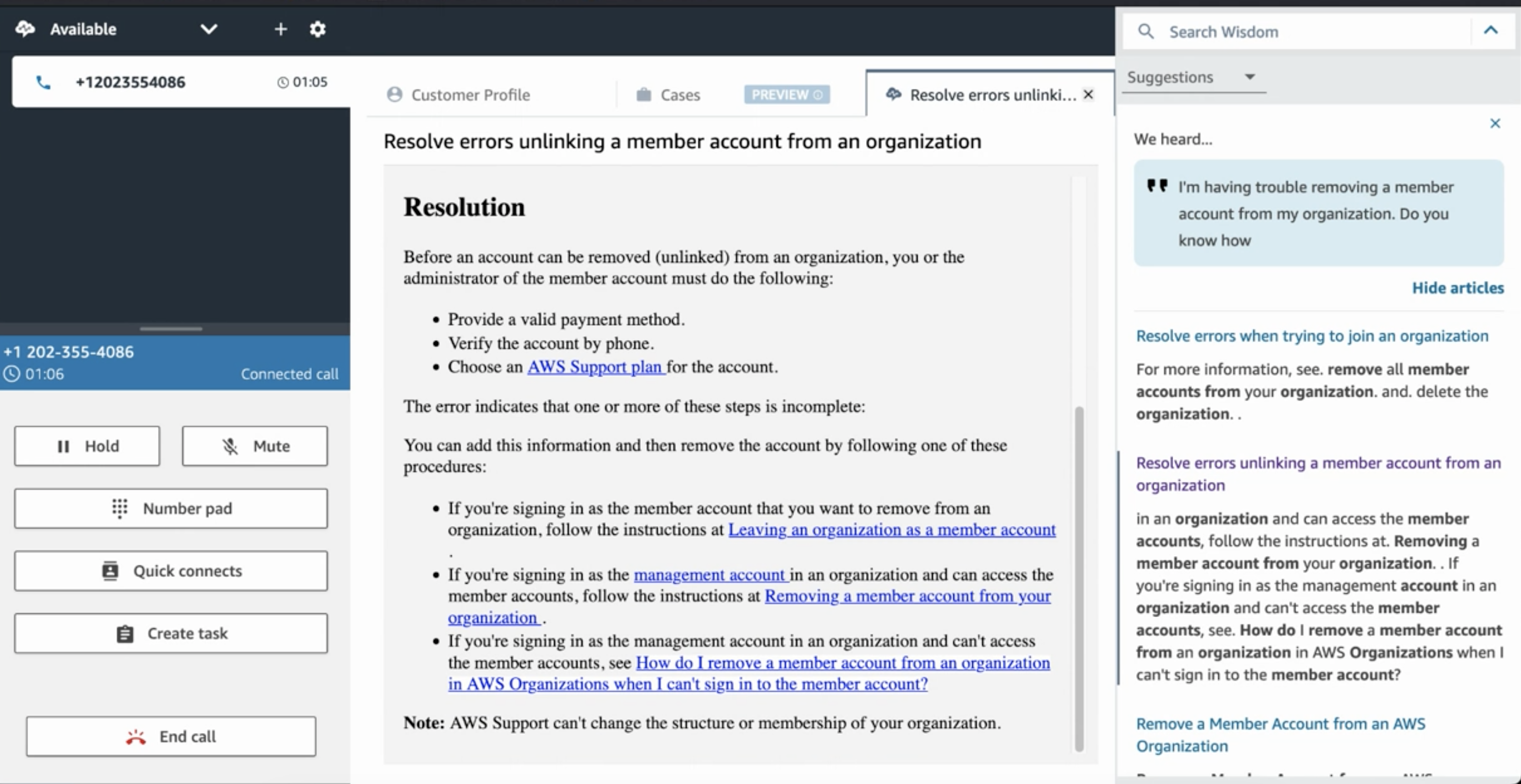Welcome to the third of our Conversations in Collaboration. We began with Cisco's Lorrissa Horton, who talked about the company's approach to data security in AI. No Jitter (NJ) then spoke with Google Cloud’s Behshad Behzadi who spoke about the use of generative AI (Gen AI) at Google, in its Contact Center AI offering and, more broadly, across enterprises.
Editor's Note: Artificial intelligence has a lot of specific, descriptive terms. Download our handy guide to AI vocabulary here.
 |
For this conversation, NJ spoke with Pasquale DeMaio, Vice President of Customer Experience services at AWS, an organization he founded in 2015. He is responsible for ensuring that Amazon Connect enables its AWS customers to support more than 10 million daily customer interactions across sales, customer service, and engagement. |
|
As DeMaio described it, Amazon Connect is a cloud-based contact center solution as a service (CCaaS) that allows companies of all sizes to deliver “great customer experiences whether they have 10 agents, hundreds or thousands.
|
Alexa, Tell Us How Amazon Connect's Use of AI Has Historic Roots
With respect to the implementation and integration of artificial intelligence (AI) into Amazon Connect (Connect), DeMaio referenced the conversational AI used in Amazon’s Alexa and its Echo devices (and apps, etc.). Conversational AI uses machine learning (ML) and natural language processing/understanding (NLP/NLU) to provide this functionality. Gen AI uses large language models (LLMs). Amazon’s conversational AI has been integrated into Connect since launch: “Our customers can right now build a natural language-based experience for their end customer.”
Connect’s Contact Lens product use conversational AI to monitor every customer/agent conversation, it can transcribe what the customer and agent are saying to each other as well as provide other functionality such as customer sentiment analysis, trends identification and can spot coaching needs for agents. In a follow-up email, Amazon said that Gen AI could potentially add value in Connect by summarizing long conversations, sharing those summaries when transferring between agents and/or delivering insights about agent performance to supervisors.
Using and Protecting Data
DeMaio said that Contact Lens can also be used to “build rules so if something goes wrong or something interesting happens in the conversation you then can act, whether that be for the agent or for supervisor or for follow up later. And our customers are taking large amounts of their customer data and bringing that together into their own data lakes and then running tools on top of that using something like an AWS SageMaker,” DeMaio said. (AWS SageMaker allows companies to create models and then run predictive analysis on their data.)
In any of these examples, whether it’s with SageMaker or Connect, DeMaio said that the customer is in control of their data. “They're not passing their data into a black box and, and we're very crisp on our Terms of Use and how we how we use data. We have a lot of strong protections for enterprise data.”
Amazon directed NJ to Section 54 in their Terms of Service which details how AWS and Amazon Connect services use and store their customers’ data For example, clause 54.7 refers to Amazon Connect Machine Learning Services which includes Contact Lens, Wisdom and other Connect services. Essentially, that particular clause states that while “AWS may use and store Amazon Connect ML Content to maintain and provide Amazon Connect ML Services (including development and improvement of Amazon Connect ML Services and their underlying technologies)…You may instruct AWS not to use and store Amazon Connect ML Content processed by Amazon Connect ML Services to develop and improve that Service or technologies of AWS or its affiliates by configuring an AI services opt out policy using AWS Organizations.”
Amazon also directed NJ to other documents that provide additional clarity around how AWS and Amazon Connect provide security and choice to customers. In this Data Privacy FAQ, Amazon states that customers maintain full control of their uploaded content, that they can choose which AWS region(s) in which their data is stored and choose the types of encryption used to protect that content while its in transit and at rest. On this page, Amazon details the privacy features of its AWS services – customers own their data, control its location and who has access to it. This page details the AWS customer agreement and this is a data processing addendum to that agreement. Amazon said that those two agreements do cover Amazon Connect.
The Foundation of Amazon’s Gen AI Strategy: Democratize the Technology
Rules-based, predictive and/or probabilistic AI approaches have been used successfully in contact centers for years. What’s excited interest among enterprises, vendors and even consumers in the last year is, of course, Gen AI.
When asked about Gen AI and its impact on the contact center DeMaio said, “I think we'll see a mix of all these types of AI moving forward. I don't think there's going to be one, one construct of AI to rule them all. In every instance you should use the applications that are the most cost effective and produce the most effective outcomes. Those are the things that really matter.”
That said, introducing Gen AI-based solutions is something businesses are moving forward with. Amazon’s approach, said DeMaio, is about “democratizing Gen AI” through Amazon Bedrock which is basically a framework for hosting different LLMs (also called foundation models). In practice, this means AWS customers can use whichever LLM they prefer. Amazon has partnered with several companies already: AI21 and their Jurassic model, Anthropic’s Claude 2 model and Stability AI’s Stable Diffusion XL 1.0, Cohere’s FMs, as well as Amazon’s own Titan LLM.
In an emailed statement in response to NJ’s request to learn a bit more about Amazon’s policies regarding the training of LLMs, Amazon said that for the Titan LLM/FM, it is committed to building and training FMs responsibly at each stage of its design, development, deployment and operations. Amazon said that it considers a range of factors including:
- Accuracy: how closely a summary matches the underlying document;
- Fairness: whether outputs treat demographic groups similarly;
- Intellectual property and copyright considerations;
- Appropriate usage: filtering out user requests for legal advice, medical diagnoses, or illegal activities);
- Toxicity: Hate speech, profanity, and insults); and
- Privacy: protecting personal information and customer prompts.
Amazon said that it is also exploring techniques across training with over-sampling, fact checking using knowledge repositories, retrieval augment generation at inference, and alignment based on human feedback.
Using Amazon Bedrock, Amazon said that it is “working to augment Amazon Connect’s existing built-in ML capabilities, including conversational analytics, agent assist, and customer self-service.”
At the time of this writing, Amazon Connect has not yet directly integrated a Gen AI tool. But, this blog post details a sample project that enables the deployment of an Amazon Lex bot that uses a pre-trained open-source LLM and the code includes a starting point to implement a custom memory manager that allows an LLM to recall previous interactions to keep the conversation’s context and pace. (Amazon Lex is an AI service that uses NL models to build conversational interfaces.)
Click-to-Add New Features as a Core Feature of Amazon Connect
DeMaio said that they’ve worked hard to make it easy to add features to Connect with a few clicks. “If you wanted to turn on the Contact Lens tools and get the benefits of its AI you just make a few clicks in the UI of Connect and it's working. Same with our prediction forecasts of contact center volumes – a few clicks and you get very accurate results.”
One area where Gen AI appears to be making contact center inroads is with agent assist. Connect has a tool called Wisdom which provides agents with assistance in real time. “It can hear the questions that customers asking us those to then query knowledge and then bring that knowledge back to help the agent without having the agent have to lift the finger to get that information.”
Interestingly, per Amazon Connect, Wisdom does not currently use Gen AI to accomplish this. Instead, “Wisdom uses real-time speech analytics and natural language processing (NLP) from Contact Lens for Amazon Connect to detect customer issues during calls, and then provide agents recommendations and answers.”
This graphic shows the agent on a call and how Wisdom prompted the agent with possible resolutions based on what it heard.
DeMaio did suggest that Connect was looking at ways to incorporate Gen AI in Wisdom. “If you have good outcomes now, we expect to have much better outcomes in the future. In fact, I just looked at a demo today of some of the work we're doing there and it's just a very, very exciting way to do this.” Some of these new approaches might involve expanding and improving agent-assist capabilities to generate real-time responses, tailored answers, and provide suggested actions based on customer history.
“When I talk to CIOs, they tell me they want to solve real world problems without putting their businesses at risk – which can happen when it comes to generative AI. There are challenges around accuracy, hallucinations, mistakes,” DeMaio said. He thinks it advisable to keep a human in the loop. “When you have agent assist, the agent can, you know, see something and ‘say yeah, that doesn’t really make sense. Or, you know, here's the right thing,’ so they’re the one who solves the problem.”
Imposing Guardrails on the Automation Processes
But one of the key areas of interest with respect to Gen AI involves customer interactions. When it comes to the real-world implementation of customer self-service, enterprises have to make sure they have the “guardrails in place and the observability required to make sure you're confident that what's happening is really effective and doesn't get you in trouble – like fraud or abuse, or expose you to regulatory risk – and is accurate to what the customer asked for,” DeMaio said.
When asked about what those controls might be, DeMaio said that though they’re still fairly early on in this in this process, “they implement through the Connect flow engine where the actions taken are monitored and maintained as distinct things so that with [a Gen AI-based bot for example], you’ll have all the logging that we have today and the guardrails where you say these are the things I want to allow the system to automate and these are the checks I want to make before I take an action as opposed to just saying, we're going to have a black box, and then we're going to just let that black box take actions on its own.”
The Agent Experience
With the human agent taking such a pivotal role – both with helping customers and, in a way, shepherding the AI deployment, what does an agent's experience working with the tools themselves look like?
DeMaio said that they’ve made the Connect UI “fairly non-intrusive so it's there when an agent wants to look at it, but if the agent wants to either get rid of it altogether, or more likely, focus on what they're trying to do and then when they see something where they want some information, it's already populated.” See the nearby graphic for an what the UI looks like.
“We've taken a relatively small portion of the screen so that the agent can see two or three maybe four ideas up there to say, hey, here is what we think might be the right solution to this problem, without taking over the screen or being aggressive and, you know, jumping up and down or something, to get your attention,” DeMaio said. “In the contact center, every pixel matters in terms of how you treat it to try and make sure that the agent has a great experience that allows them to really focus on the customer.”
NJ also asked DeMaio about the potential effect of AI adoption, Gen AI-based or otherwise, on contact center agents. As a AI-based solutions become the norm for all customer self-service, as an example, then what happens if agents start having to handle more emotionally charged customer interactions?
“First off, I would say that that agent turnover is a very real problem in our business,” DeMaio said. “Second, handling angry customers is obviously not the favorite part of an agent’s job, but I’ve seen so many times people who are just incredible at it. They handle these things in such a direct way, ways that I'm jealous that my own interpersonal skills aren’t at their level.”
He continued, saying that even with just basic solutions these intense interactions can be made better for the agent – just knowing why they’re calling ahead of time can be a huge benefit. And then if the tool “shows the agent what the likely solution is or suggesting the exact wording to use, even if the agent is really experienced, can be a very powerful thing.”
DeMaio suggested that if the premise of the “irate” customer is removed and the AI-powered system is automating the simple things, “maybe the agents get to deal with things that are more interesting – that gives them an opportunity to figure something new out that’s rewarding when you solve it. And I think that can help agents be more engaged and excited.”
Want to know more?
Check out these articles and resources:












